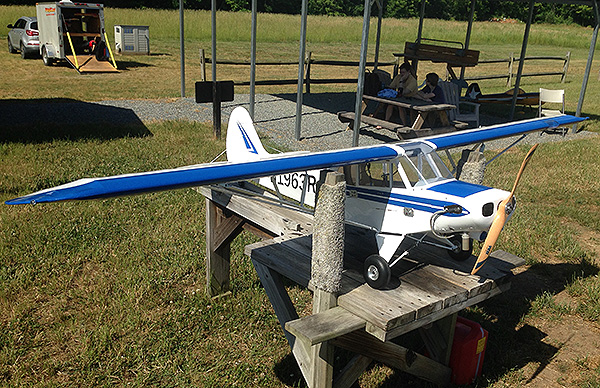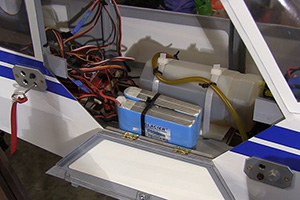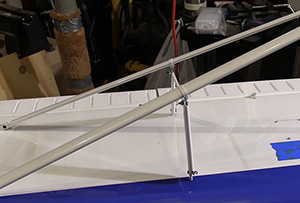



The Cub is one of those classics everybody want to have at least once while
flying RC. Many of us never get over that desire.
Text, photos and video by Tom Hintz and Clark Ponthier
Posted – 6-30-2015
Maiden day for my Hangar 9 1/4-scale PA-18 Super Cub turned out to be rather windy with the major gusts coming at a treacherous 45-degree angle to our runway. Getting my Cub to just taxi down the runway with both wheels on the ground was a chore because the up wind wing was seeing plenty of airspeed to fly and was pushing the other wing tip near the ground. But, it was Saturday and I can only fly on weekends these days so wind is something to deal with but I can’t let it be a deal breaker.
It didn’t take long to find out that the DLE40 Twin packed way more power than the Hangar 9 1/4-scale PA-18 Super Cub needed. After a surprisingly short roll out it was airborne and pointed skyward. Gaining altitude is not an issue for the Hangar 9 1/4-scale PA-18 Super Cub. I throttled back to about 50% power, added several clicks of down trim, a few clicks of right aileron trim and the Hangar 9 1/4-scale PA-18 Super Cub was flying pretty straight and level.
Get off the gas altogether and the nose tends to drop some but is easily countered with a touch of elevator. This trait is actually a good thing because the Hangar 9 1/4-scale PA-18 Super Cub wing has so much lift. When shooting landing approaches in any kind of wind having the nose push itself down a little helps keep this plane stable and predictable as it gets closer to the ground.
The biggest problem with the Hangar 9 1/4-scale PA-18 Super Cub is that the huge wing requires precious little wind to keep flying, plus the upwind side goes into hyper-lift in response to gusts. The good news is that if you keep the upwind wing slightly down (as we should anyway) the Hangar 9 1/4-scale PA-18 Super Cub comes back to the ground under control. Actually that is a little generous. The Cub gets near the ground but then wants to keep flying at ridiculously slow speeds, even without the flaps deployed. I found that it is easier to land the Hangar 9 1/4-scale PA-18 Super Cub with the flaps at about 40-degrees and just enough elevator mixed in to force you to hold a little up elevator to control the sink. The flaps slow the Cub enough that you can add a touch of throttle in bumpy winds and it smooths right out when you get down to 4 or 5 feet above the runway. Once you get the feel of the Hangar 9 1/4-scale PA-18 Super Cub in the wind it is actually rather easy to land.

The interior gets full fast so some planning
is helpful.
Cubs have always been rudder friendly and the Hangar 9 1/4-scale PA-18 Super Cub is no different. Use aileron and elevator only and a Cub drags its tail through the turn at an odd-looking angle. With the DLE40 Twin my Hangar 9 1/4-scale PA-18 Super Cub will keep its tail in line petty good at full throttle without rudder. But slow it to more Cub-like speeds and a touch of rudder and the turns becomes coordinated and look right, plus you have better control overall.
The elevators are large and very effective on the Hangar 9 1/4-scale PA-18 Super Cub. It has a relatively long tail moment so there is lots of leverage to further sensitize the large elevator surfaces. I like to modulate the controls manually but if you are not a fan of sensitive controls be sure to set up some dual rates. Like the rudder the elevators remain very active at very slow speeds so you can get yourself into rather serious trouble if you start jerking on the sticks.
Ailerons feel like we forgot to hook one up. No matter what you do short of redesigning the wing completely the Hangar 9 1/4-scale PA-18 Super Cub ailerons will never produce anything we can legitimately call a fast roll rate. The good news here is that you have plenty of time to learn how to support a roll with down elevator because it spends a good amount of time in the inverted half of the roll. The only thing that increases the roll rate noticeably is more speed but the Hangar 9 1/4-scale PA-18 Super Cub will never have more than a relatively scale roll rate.
Some will try to hasten rolls by adding rudder which sounds right but is more likely to produce a surprisingly quick snap roll for such a large plane and wing. There is no middle ground here. The rolls are either slow or the Hangar 9 1/4-scale PA-18 Super Cub goes into a snap.
The problem with Hangar 9 1/4-scale PA-18 Super Cub snaps rolls is that once it gets going it doesn’t want to stop. I did have the good sense to try my normal take off snap roll kind of high and was glad I did. The Hangar 9 1/4-scale PA-18 Super Cub over rotated and finished the snap in a hard left bank. It also loses a bunch of airspeed when you flatten that big of a wing to the air but it comes back surprisingly quick but be ready to give it a bunch of right to stop the snap and fly away.

If you fly Cubs, you have to get used
to functional struts.
The instruction manual calls for the CG to be located 4” to 4-3/4” back from the leading edge of the wing. I put the CG on my Hangar 9 1/4-scale PA-18 Super Cub at 4-1/2”. Part of my reasoning is that I moved the fuel load back from the nose where the instructions put it to where it is nearly on the CG so burning fuel off has little impact on the CG. I am also accustomed to flying planes with a slightly tail heavy CG because I like the more “active” control responses.
For many putting the CG closer to the 4” mark will produce a more stable, predictable plane with all the control capability you need. The elevator on my Hangar 9 1/4-scale PA-18 Super Cub remains sensitive all the way to the ground and can get you into trouble if you pull in too much. If you are unsure at all, start at the forward-most CG location and then work your way back as you gain familiarity with how that plane flies.
The instruction manual has good suggestions on setting up the flaps so follow those specs. A friend with lots of Cub experience actually set up my flaps and the mixed-in elevator offsets. Later I matched these to the ones suggested in the manual and found that we are very close so I am confident in suggesting you use the recommended flap specs and then tweak them later if you want after gaining some flight time on the Hangar 9 1/4-scale PA-18 Super Cub.
As with any plane you will want to spend a little time becoming accustomed to using flaps and how the throttle has to be worked to keep the plane stable. Because the flaps create so much drag along with the lift a little more motor rpm is needed to maintain speed. Usually the amount of needed throttle is small so I flattened the first 50% of the throttle curve to make it easier to be precise with lower rpm throttle positions.
Many will try to soften the suspension up trying to absorb bouncy landings. I did as well and it bit me. On the first day flying the Hangar 9 1/4-scale PA-18 Super Cub I softened the suspension and then on the next take off I gave it a bunch of power, obviously too early and the left side suspension apparently flexed out and dropped the left wing tip down where it grabbed the ground and I cartwheeled it. Damage was confined to the top of the cabin area and a friend who is a master builder put it back together like it never happened.
I have to be honest about this. The crash did not result from anything the Hangar 9 1/4-scale PA-18 Super Cub did wrong. It was all me. I gave it way too much power for a cross wind takeoff in the gusts we had that day, plus softening the gear forced the Cub to essentially trip. My bad and I am lucky the damage was not worse and that I had Dennis to fix it right.
Since that incident I roll the throttle on during takeoff, pay more attention to the wind and use a stiffer setting on the suspension. I don’t like crashing any more than anyone else so try to learn from dumb moves to preserve my planes.
The Hangar 9 1/4-scale PA-18 Super Cub is a fun plane to fly particularly if you enjoy using the rudder. I would hesitate to put this in the trainer category but it is not far from it. Low speed handling is spot on yet with the DLE40 Twin the Hangar 9 1/4-scale PA-18 Super Cub is surprisingly quick in the air. You do have to remember how big the wing is and that it takes a little longer to complete a roll.
As you would expect the rudder is very effective and the Hangar 9 1/4-scale PA-18 Super Cub likes you using it to coordinate turns and slide it around flat turns. What is kind of unusual about the Hangar 9 1/4-scale PA-18 Super Cub rudder is that it really does not have any bad habits even when a good amount is used. I have been able to yaw the Hangar 9 1/4-scale PA-18 Super Cub quite a bit before it wanted to snap but that tendency seems to grow as speed is reduced so don’t get too brave too low until you get used to it!
I paid $619.99 (with free shipping at the moment 5-24-2015) and am happy with what I got for the money. The included hardware is more than adequate which means less to buy just to get this model in the air. The Hangar 9 1/4-scale PA-18 Super Cub is a good value in today’s RC plane world and one that will provide lots of fun for a very long time if you can avoid doing something very wrong.
Visit the Hangar 9 1/4-scale PA-18 Super Cub product page – Click Here
Have a comment on this review? –Email Me!